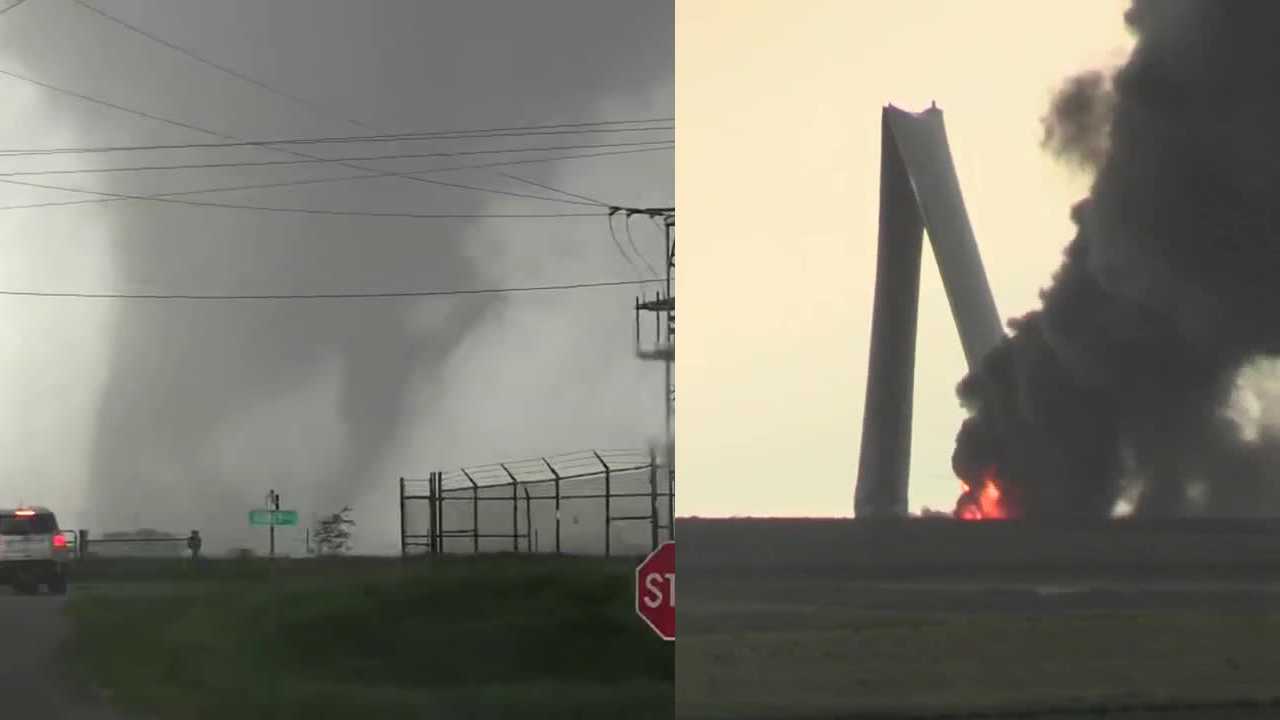Overview of Tornadoes in Iowa
Tornado iowa – Iowa has a long and well-documented history of tornadoes. The state is located in the middle of Tornado Alley, a region of the central United States that experiences a high frequency of tornadoes. Iowa’s geographical location and climate make it particularly vulnerable to tornadoes.
Tornadoes in Iowa can be devastating, as evidenced by the recent Greenfield, IA tornado . The damage caused by this tornado was widespread and severe, leaving many residents without homes or businesses. The community is still recovering from the storm, but the resilience of the people of Greenfield is inspiring.
Despite the challenges they face, they are determined to rebuild their lives and their community.
The most common type of tornado in Iowa is the supercell tornado. Supercell tornadoes are long-lived and can travel for hundreds of miles. They are often associated with large hail and heavy rain. Iowa also experiences a number of weak tornadoes, which are typically short-lived and cause less damage.
Geographical and Meteorological Factors
Iowa’s geographical location plays a major role in its tornado activity. The state is located in the middle of the Great Plains, which is a flat, open area that allows tornadoes to travel long distances without dissipating. Iowa is also located in the path of the jet stream, which is a high-altitude wind current that can help to create tornadoes.
The recent tornado outbreak in Iowa has caused widespread devastation, leaving communities in ruins. Among the hardest-hit areas is Greenfield, where the tornado left a trail of destruction. Click here to see the extent of the damage and learn how you can help those affected by the tornado in Iowa.
The climate of Iowa also contributes to its tornado activity. Iowa has a humid continental climate, which means that it experiences hot, humid summers and cold, dry winters. The warm, moist air in the summer provides the energy that is needed to create tornadoes.
The recent tornado in Iowa has left a trail of destruction, including severe damage in the town of Greenfield. Greenfield tornado damage includes downed power lines, damaged buildings, and uprooted trees. The storm has also caused power outages and disruptions to local businesses.
The tornado is a reminder of the destructive power of nature and the importance of being prepared for severe weather events.
Frequency and Severity
Tornadoes can occur anywhere in Iowa, but they are most common in the western and central parts of the state. The frequency of tornadoes in Iowa varies from year to year, but the state averages about 50 tornadoes per year.
The severity of tornadoes in Iowa also varies. Some tornadoes are weak and cause little damage, while others are strong and can cause widespread destruction. The most powerful tornado ever recorded in Iowa was the Parkersburg tornado, which occurred in 2008. The Parkersburg tornado was an EF5 tornado, the highest rating on the Enhanced Fujita Scale. It killed six people and caused over $2 billion in damage.
Impacts of Tornadoes on Iowa

Tornadoes have had a profound and devastating impact on Iowa’s infrastructure, economy, and communities. These storms have caused widespread damage to buildings, roads, and bridges, resulting in significant economic losses and disruptions. The social and emotional impacts of tornadoes on Iowa’s communities have also been profound, leaving lasting scars on the lives of those affected.
Infrastructure Damage
Tornadoes have caused extensive damage to Iowa’s infrastructure, including buildings, roads, and bridges. The high winds and debris carried by tornadoes can cause severe structural damage to buildings, often rendering them uninhabitable. In some cases, tornadoes have completely destroyed buildings, leaving behind only rubble. Tornadoes can also damage roads and bridges, making them impassable and disrupting transportation networks. The repair and reconstruction of damaged infrastructure can be a costly and time-consuming process, placing a strain on local resources.
Economic Losses and Disruptions, Tornado iowa
Tornadoes can cause significant economic losses and disruptions in Iowa. The damage to buildings, roads, and bridges can lead to business closures and job losses. The disruption of transportation networks can also hamper economic activity, making it difficult for businesses to receive supplies and ship products. The cleanup and recovery efforts following a tornado can also be costly, further straining local economies.
Social and Emotional Impacts
Tornadoes can have a profound social and emotional impact on Iowa’s communities. The destruction of homes and businesses can leave people feeling displaced and vulnerable. The loss of life and property can also lead to grief, anxiety, and depression. Tornadoes can also disrupt social networks and community cohesion, making it difficult for people to rebuild their lives. The long-term effects of tornadoes on Iowa’s communities can be significant, as people struggle to cope with the physical and emotional scars left behind by these storms.
Preparedness and Mitigation Strategies
Tornadoes pose a significant threat to Iowa, making preparedness and mitigation strategies crucial. By implementing effective measures, communities can reduce the risks and minimize the devastating impacts of these storms.
Early warning systems, such as tornado sirens and mobile phone alerts, provide critical lead time for residents to seek shelter. Storm shelters, including underground bunkers and reinforced structures, offer safe havens during tornadoes.
As tornadoes ravage Iowa, Greenfield residents can find solace in a detailed greenfield iowa map . This map provides a comprehensive overview of the area, allowing residents to identify evacuation routes and shelters in case of an emergency. With the threat of tornadoes looming, staying informed and prepared is crucial for the safety of all Iowans.
Community Outreach Programs
Community outreach programs play a vital role in educating residents about tornado safety. These programs distribute preparedness materials, conduct drills, and promote community awareness about tornado risks and response protocols.
Building Codes and Land-Use Planning
Building codes that mandate tornado-resistant construction standards, such as reinforced walls and impact-resistant windows, help mitigate damage. Land-use planning, which regulates development in tornado-prone areas, can also reduce risks by limiting construction in vulnerable locations.
Climate Change and Tornadoes

Climate change is a complex and multifaceted phenomenon with far-reaching implications for various aspects of our planet, including weather patterns and the frequency and intensity of natural disasters. Tornadoes, as one of the most destructive forces of nature, are also likely to be affected by climate change, posing significant challenges for communities in tornado-prone regions like Iowa.
The potential impacts of climate change on tornado activity are still being studied and debated, but several key factors are expected to play a role:
Changes in Temperature
- Rising temperatures can lead to increased atmospheric instability, which is a key ingredient for tornado formation.
- Warmer air can hold more moisture, which can contribute to the formation of more intense thunderstorms, the precursors to tornadoes.
Changes in Precipitation Patterns
- Changes in precipitation patterns can affect the frequency and severity of droughts, which can in turn influence the availability of moisture for thunderstorm development.
- Increased rainfall can lead to flooding, which can alter the landscape and create new areas vulnerable to tornadoes.
Changes in Wind Patterns
- Changes in wind patterns can affect the direction and speed of tornadoes, potentially making them more unpredictable and difficult to track.
- Stronger winds can also lead to more intense tornadoes, causing greater damage.
The challenges posed by climate change require communities to adapt and develop strategies to mitigate the potential impacts of tornadoes. These strategies may include:
- Improving early warning systems and evacuation plans.
- Investing in tornado-resistant construction and infrastructure.
- Educating the public about tornado safety and preparedness.
- Conducting research to better understand the impacts of climate change on tornadoes.
By taking these steps, communities in Iowa can help to reduce the risks associated with tornadoes and build resilience to the challenges posed by climate change.
Tornadoes in Iowa are a force of nature, leaving behind a trail of destruction. To better understand their patterns and stay prepared, the iowa tornado map provides a comprehensive overview of tornado activity in the state. By studying these maps, we can identify high-risk areas and develop strategies to mitigate the impact of future tornadoes, safeguarding our communities and loved ones.
Historical Case Studies
Iowa has a long and destructive history with tornadoes, with some of the most significant events occurring in the past century. These historical case studies provide valuable insights into the characteristics, impacts, and lessons learned from these catastrophic events.
The effectiveness of preparedness and mitigation strategies in these case studies has varied, highlighting the importance of continuous improvement and adaptation to enhance community resilience.
The Des Moines Tornado of 1947
- Characteristics: An F5 tornado with winds exceeding 200 mph, it traveled over 20 miles, leaving a path of destruction over a mile wide.
- Impacts: Devastated the city of Des Moines, killing 135 people and injuring over 500. Over 2,000 buildings were destroyed, including homes, businesses, and schools.
- Lessons Learned: The tornado highlighted the need for improved building codes and emergency preparedness plans. It also led to the establishment of the National Severe Storms Forecast Center.
The Parkersburg Tornado of 2008
- Characteristics: An EF5 tornado with winds reaching 205 mph, it traveled over 80 miles, becoming the longest-tracked tornado in Iowa history.
- Impacts: Caused widespread damage in several towns, including Parkersburg, New Hartford, and Cedar Falls. 11 people were killed, and over 100 were injured.
- Lessons Learned: The tornado demonstrated the importance of early warning systems and community preparedness. It also led to improvements in building codes and tornado shelters.
The derecho of 2020
- Characteristics: A widespread and destructive derecho, a line of thunderstorms with high winds, caused significant damage across Iowa.
- Impacts: The derecho caused widespread power outages, damaged homes and businesses, and uprooted trees. Four people were killed, and dozens were injured.
- Lessons Learned: The derecho highlighted the need for improved infrastructure resilience and community preparedness for extreme weather events.
Future Research and Policy Directions: Tornado Iowa
As we continue to grapple with the devastating impacts of tornadoes in Iowa, it is imperative that we prioritize research and policy initiatives to enhance our preparedness, mitigation, and recovery efforts. By addressing knowledge gaps and exploring innovative approaches, we can strive to reduce tornado risks and build more resilient communities.
One key area for future research lies in improving our understanding of tornado formation and behavior. By studying the atmospheric conditions that lead to tornadoes, we can gain insights into their predictability and develop more accurate forecasting models. Additionally, research on the impact of climate change on tornado activity is crucial for assessing future risks and developing adaptation strategies.
Policy Initiatives
To enhance tornado preparedness and mitigation, several policy initiatives could be considered:
- Strengthening building codes to ensure that new structures are designed to withstand tornado forces.
- Investing in community-based warning systems to provide timely alerts to residents.
- Implementing public education campaigns to raise awareness about tornado safety and preparedness measures.
Innovative Technologies
Exploring innovative technologies can also contribute to reducing tornado risks. These include:
- Developing advanced radar systems to detect and track tornadoes with greater accuracy.
- Utilizing artificial intelligence to analyze weather data and predict tornado formation.
- Creating mobile applications that provide real-time tornado alerts and safety information.